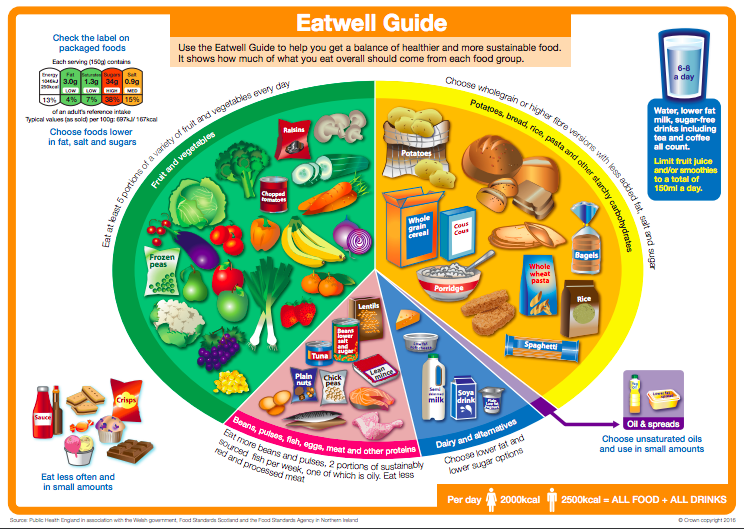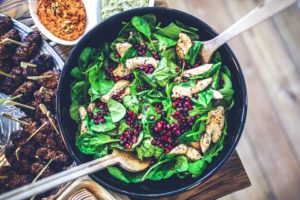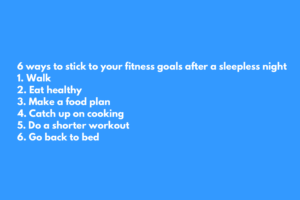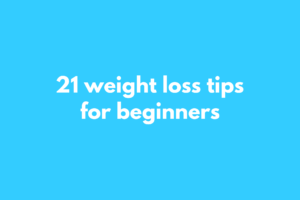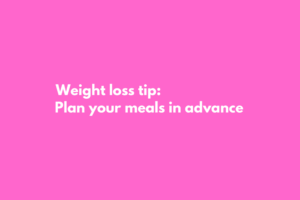I’m often asked for my top weight loss tips, so I’ve put together a post that contains the many tips I’ve picked up over the years that have helped me to lose 4 stone and keep it off for quite some time now. These are not quick fixes, but practical steps you can take to improve what and how you eat. These weight loss strategies have also helped me to improve my relationship with food and how I view my body. If your New Year’s Resolution is to lose weight, I hope you find these useful and I hope that you are kind to yourselves in the process of changing your eating habits and associated behaviours.
1. Record what you eat
Tracking what you eat is a simple way to keep an eye on what you’re consuming, as it’s quite easy to forget what you eat, especially if you’re prone to snacking. It’s also a useful tool to adopt if you calorie count or want to track how much protein, carbs or fat you’re consuming. Apps such as MyFitnessPal are great for tracking and recording your progress, but simply writing down what you eat on a piece of paper is just as useful.
2. Plan your meals in advance
I’m a huge plan of meal planning. All you need to do is jot down what you plan to eat and when. I find this helps you to make and stick to healthy choices “in the moment”.
3. Walk more
I always think that walking is a hugely underestimated form for exercise. It’s a great fat burner, free to do, relaxing, and suitable for all fitness levels. Incorporate it into your everyday schedule or set some time aside to take a stroll.
4. Eat way more vegetables then you’re currently doing
Vegetables are full of vitamins and minerals that will leave you feeling great in so many ways, plus they’re a wonderful source of fibre and can help fill you up for very few calories. Include a large portion of veg with as many meals as possible. Carrots, cucumbers, peppers, celery and fruit make great snacks too.
5. Be kind to yourself
In the pursuit of weight loss many of us can be very cruel to ourselves – whether that’s in the form of starving your body from food or having negative thoughts and opinions about yourself. For anyone wishing to lose weight, please do be kind to yourself. It can take time to lose weight and for long-lasting results it’s far better to work on creating new, healthy eating and exercise habits one step at a time that are sustainable. Although this book – Body Positive Panda – isn’t a weight loss book, I would highly recommend reading it if you continually find yourself having negative thoughts about your body, or feel you may behave in a less than positive way towards yourself. This book does not advocate dieting, so it may seem like a very strange thing for me to recommend it, but it helped me to put my weight loss goals in perspective and re-evaluate why I’m wanting to lose weight and if I actually want or need to. After some time asking myself some difficult questions, I realised that I have a genuine interest in nutrition and I enjoy exercising, so from a distance it might not seem that a lot has changed in my behaviour but take my word for it that mentally and emotionally, I’ve experienced a huge shift in my attitude towards weight loss and I feel far happier and healthier for it.
6. Remember the basics of weight loss
There are a lot theories when it comes to successful weight loss methods, but there is one fundamental thing experts agree on – consume less than you’re using. If you eat more than you’re ‘burning off’ you can gain weight. Plus, there’s undeniable research when it comes to the benefits of consuming a wide range of fruit, vegetables and foods as close to their natural state as possible (e.g. heavily fried or processed foods are never featured in a healthy weight loss plan for this reason). I find this helpful to keep in mind when I feel conflicted by healthy food messages or if a new fad diet appears on the scene. A healthy diet consists of a wide range of fruit; vegetables; wholegrains (brown rice for example); legumes; pulses; protein (e.g. chicken, tofu, salmon, eggs); healthy fats (found in avocado for example), lots of water and exercise.
7. Food shop online
Supermarkets can be tempting places, with buy one get on free offers on foods that tend to be high in fat and calories, and low in vitamins and minerals. Once you’ve made a meal plan for the week ahead, why not shop online as a way to reduce the temptation to buy foods that aren’t great for your health or weight loss goals.
8. Cook from scratch whenever possible
This is a simple way to reduce salt, sugar and saturated fat in your diet, as many pre-made sauces and ready meals contain a higher proportions of these compared to when you cook a meal with fresh ingredients from scratch. Plus, cooking from scratch is an easy way to include a load of vegetables – think soups, stews, curries and stir fries.
9. Cook in batches
If getting in the kitchen to cook everyday is impractical, then start ‘batch cooking’ and save the extra portions in the fridge or freezer for future meal times.
10. Enjoy fruit as a dessert or afternoon snack
Fruit is naturally sweet and makes for a great dessert or snack, especially if you have a sweet tooth. Fruit needn’t be ‘boring’ either. I personally love a piece of fruit but I also love making banana ice cream (blend a frozen banana with some milk – that’s it), fruit sorbets (more frozen fruit in a blender), fruit salads, mixing fruit with some yogurt or making a smoothie. Plus, you’ll be consuming a load more vitamins, minerals and fibre too!
11. Eat more protein
Lean sources of protein can really help you to feel fuller for longer, and reduce the urge to overeat on foods that may not be great for you. My favourite protein sources are plain greek style yogurt, quark, chicken, tuna and salmon. I also love lentils and beans, which are great sources of fibre too. I should state here that I’m not an advocate for cutting out carbs, but when it comes to breaky, lunch and dinner I have found it beneficial to reduce my carb portion sizes slightly, if favour for a larger portion of protein and veg.
12. Eat more fibre
Nutritionists and health experts often report that we do not consume enough fibre, and we can all benefit for upping our fibre intake. Fibre ensures you have a healthy working gut, are ridding your body of toxins and, well let me just say it – stools! Stay regular by opting for brown rice, brown bread, lentils, beans and green leafy vegetables. There are many other benefits too and I personally have found in recent years, that increasing my fibre intake has helped significantly with my weight loss.
13. Join a group
The buzz of other people working out or eating healthy is infectious and I’ve always found it beneficial to be around people with a similar goal. Groups can come in so many forms, so have fun finding one that works for you and keeps you motivated. It could be a group (online or in person) where you discuss healthy food choices (like WW), or a local exercise class or gym where you naturally have conversations with those taking part about their goals and share tips. Or, start your own group with friends and family and motivate each other to try new healthy recipes and new activities.
14. Learn from the process
If you have a ‘bad’ day and go off track, try not to beat yourself up about it. Put it in perspective and learn from it. For example, I would overeat anytime I would restrict my food intake too much during the day. This may sound silly but it’s almost as if I thought I wasn’t allowed to eat while trying to lose weight. That is ridiculous, we all have to eat. I learned that I simply needed to eat more nutritious foods and not to let hours and hours go by without eating, as that was also a trigger for me to indulge on high fat and high calorie foods.
15. Eat
Eating less and burning more will create a calorie deficit that will lead to weight loss, but please don’t take that to the extreme. From experience, when you eat more nutritious foods (such as lean protein, fruit, vegetables, brown rice and bread, lentils, beans) you may feel as though you’re actually eating more than you’ve ever done before. Your body will thrive on receiving all the right macronutrients (fat, protein and carbs) and micro (vitamins and minerals) nutrients it needs.
16. Forget ‘good’ and ‘bad’
I’m guilty of referring to myself as having been ‘bad’ if I eat a piece of chocolate or as if the chocolate itself is ‘bad’. For me it’s important to establish and share that eating chocolate (or any other food not on a superfoods list) doesn’t make you a bad person. There are no ‘bad’ foods; some foods do have higher nutritional benefits than others but eating chocolate or crisps doesn’t make you bad. If you like these foods, enjoy them in moderation and don’t be hard on yourself after eating them. Life is too short for that.
17. Be mindful of your portion sizes
Without sounding confusing having just said eat and forget good and bad foods, for weight loss a deficit between what you’re consuming and what your using needs to be created. I went through a time when I just wasn’t losing weight, even though I felt as though my diet was healthy and any treats I had were in moderation. It came as a bit of a shock to me when I realised (through research and talking to a PT and weight loss coach) that I was simply overeating – even though the foods I was consuming were healthy. Here’s a link to a handy portion size guide I came across online.
18. Be mindful when you eat
As much as possible sit down to eat and focus on your food without distractions – even if you’re just having a snack or a hot drink. When you eat while watching TV for example, it’s easy to consume your food without really acknowledging it and that can leave us wanting more food than we need. Try to savour every moment and make eating a fun event.
19. Enjoy feeling better
While I understand the happiness that can come from losing weight, I also want to shout about the benefits of eating well and exercising more, because this has (ever since I started to really change my eating habits for the better) always been a surprising benefit. Binge eating on chocolate and consuming portion sizes way bigger than I needed for my lifestyle I believe where the reasons why I was overweight and felt so lethargic. Eating more natural foods and moving more has given both my energy and confidence levels a huge boost. Eating better makes me feel better and every time I complete an exercise (be it running, cycling, or weight lifting) without wanting to keel over, I feel extremely proud of how far I’ve come and how much stronger and fitter I am today.
20. Weigh yourself just once a week
Weighing yourself is one way to measure your progress, and if you do weigh yourself regularly please only do it once a week – ideally at the same time each week, first thing and in the nude! If that’s not possible, weigh yourself on the same day, at the same time each week wearing similar clothes each time. Weighing yourself throughout the week can be disheartening if the number on the scales fluctuates, which is does depending how what you’ve eaten, how much you’ve drunk and so on. Other measures you may like to try or consider are how you feel; how your clothes feel; you may be able to access scales that tell you your body composition and see if your ratio of fat to muscle changes over time; or a measuring tape – so that you can see if you’ve lost inches from your waist, hips, thigh and arms for example.
21. Make one change at a time
There are many ways to achieve successful, healthy weight loss. In this post alone are 21 tips and I wouldn’t blame you for feeling a little overwhelmed if you’ve reached the end of the post and aren’t sure where to start. While you lose weight focus on one area (or tip provided in this post) you could change at a time. Focus on that area for a week and give yourself time at the end of the week to review your progress and see if you’re ready to focus on another area.
If you’ve enjoyed this post and have found it useful, please like, share and comment; and I wish you the best with all your health goals, you can do it!
Chloe
